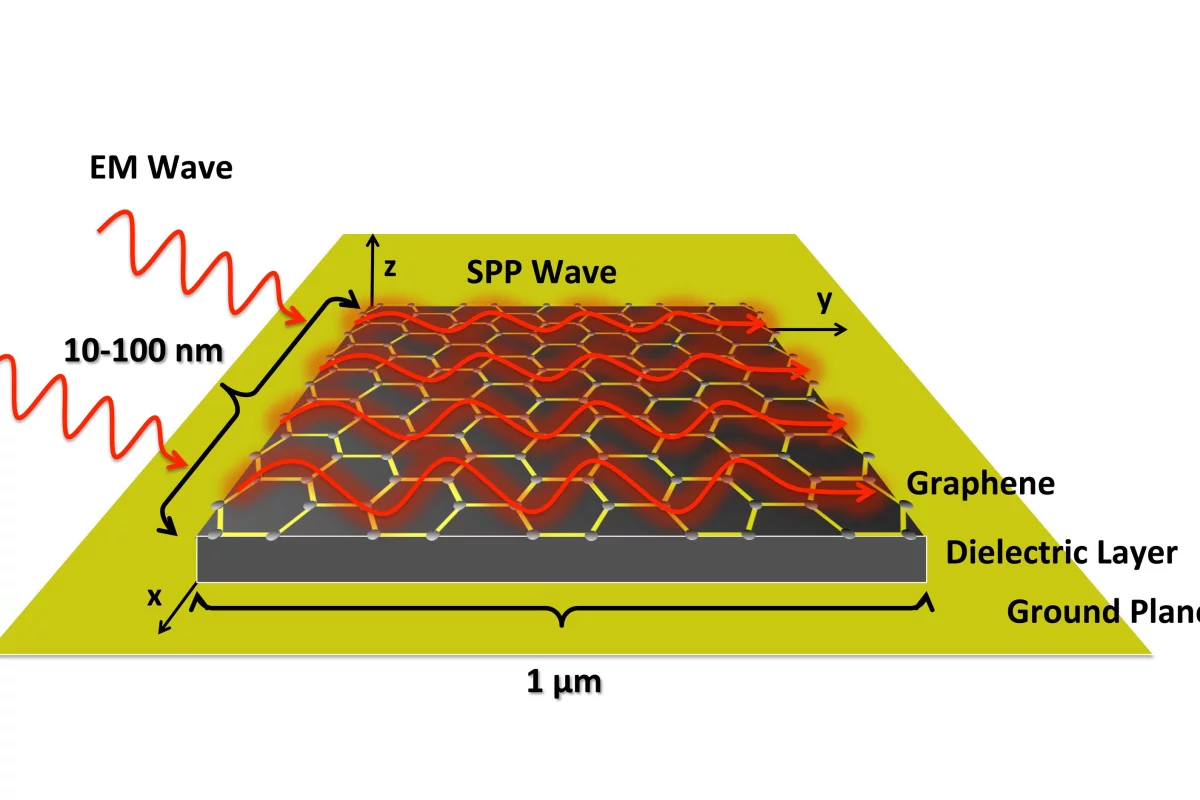Smart dust. Utility fog. Programmable matter. Grey and blue goo. Cooperating swarms of micron-sized devices (motes) offer completely new solutions and capabilities that can hardly be imagined. However, cooperation requires communication, and conventional radio or optical networking simply isn't practical at this size. Now researchers at Georgia Tech have invented a plasmonic graphene nano-antenna that can be efficiently used at millimeter radio wavelengths, taking one more step toward smart dust.
Graphene is a two-dimensional sheet of carbon atoms that is positioned to become one of the wonder materials of the 21st Century. Among graphene's unique properties is that its transport electrons behave as if they are without mass, and travel at about 0.3 percent of the speed of light regardless of their energy.
This speed limit implies that the wavelength of surface plasmon polaritons for a given frequency will be several hundred times smaller than the wavelength of freely propagating electromagnetic waves of the same frequency. The Georgia Tech team has demonstrated that this difference in speed enables graphene-based antennas to be far smaller than antennas made using conventional materials while retaining about the same efficiency.
Why do we want tiny electromagnetic antennas?
One of the barriers to creating smart dust, cooperating swarms of micron-sized devices, is to enable the communication required for self-guided group activity. At such small sizes, a communications system runs into to a number of constraints, such as available energy and power, the size of resonant structures, signal diffraction, and quantization limits. Let's look at an example to clarify these factors.
Imagine a smart dust mote in a one-micron cube. The mass of this cube will be somewhere in the neighborhood of a picogram. If a tenth of the cube were a next-generation supercapacitor, the amount of stored energy would be about 10 picojoules, and the power density about 1 picowatt.
Having a radiation source/detector a micron in size means that electromagnetic waves used for communication should have a wavelength smaller than that, or above about 300 THz (near-infrared light). At present, this would limit our mote to using semiconductor optoelectronics for communication. Lasers can be made small enough to use, but require too much energy to reach their lasing threshold, which restricts smart dust to LEDs and photodetectors.
With photon efficiency of about ten percent, an electrical picowatt would generate about 600,000 IR photons per second. The IR radiation would be emitted in a near-hemispheric pattern, owing to diffraction of the emitted light from the edges of the LED chip. Also, only ten percent of the photons hitting another mote will be converted into electrons.
Working the numbers out shows that to achieve a data rate of one-bit-per-second with a signal/noise ratio of 10:1 requires that communicating smart dust particles can only be separated by about 35 microns.
While long-range messages can be passed through intermediaries to any location within the swarm, a swarm large enough for most purposes would have to contain a huge number of motes to ensure connectivity. The numbers are so large that it seems reasonable to search for another approach to communication.
Graphene-based plasmonic antennas
The newest approach involves graphene-based plasmonic antennas. Unlike plasmonic antennas based on noble metals, these would allow smart dust to operate at frequencies at least 100 times (and in principle perhaps 1000 times) smaller than is possible using a conventional metallic antenna.
The operating principle is that an electromagnetic (EM) wave directed onto a graphene surface perpendicular to that surface excites the electrons in the graphene into oscillations. These electrons interact with those in the dielectric material on which the graphene is mounted, thereby forming surface plasmon polaritons (SPP).
When the antenna becomes resonant (meaning that an integral number of SPP wavelengths fit into the physical dimensions of the graphene), the coupling of the SPP and the external EM waves increases greatly, resulting in efficient transfer of energy between the two.
When receiving, the energy of the SPP is bled off into a transceiver. When transmitting, the electron density of the graphene is modulated to drive formation of the SPP, which then convert into EM waves and propagate away, taking the energy pumped into the SPP along. The Georgia Tech researchers are also working on compatible graphene-based transceivers, an effort worth watching.
Note that the smaller frequency means that one can generate 100-1000 times more photons for the same amount of power, extending the communication range between two micron-sized motes to about 0.35-1.0 mm (0.014-0.04 in), thereby reducing the number of motes for a swarm with a given physical dimension at least a million-fold.
There are other applications for such small antennas. For instance, a phased array antenna measuring only 100 microns in diameter might be used to produce 300 GHz beams only a few degrees in diameter, instead of the hemispherical radiation expected from a conventional metal antenna 100 microns in size.
This could be used to make practical terabit-per-second wireless networks for smartphones and computers, while avoiding being crippled by the power loss associated with the propagation of sub-THz radio waves through the atmosphere. However the story ends, it is yet another example of what novel behaviors graphene is capable.
Source: Georgia Institute of Technology




